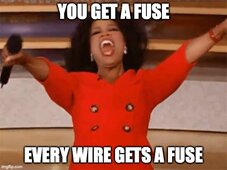Having a larger array using a combiner box , each string is fused on pos & neg…. It is 4S-4P …works great…
The new Panels I’m adding are multiple 4 panel PODS…. Each pod is 2S-2P with no combiner box …..each with its own blue CC.. the Panels have 10ga wire from factory.
Each has an IMO isolater switch and a MS SPD located at the array..
The PV cable from each pod is 6 ga tinned copper and 100 ft long back to the gear location ,slightly buried &.contains the bonding wire ..
Each series string (2) in each pod is about 70;volts / & 13a..this will be parrallel with the other string in the pod of the same values..so each paralleled pair of cables going underground from each pod ,back to the gear = about 70 volts & 26a…….
I have read here many times one doesn’t need to fuse a 2 P array…
With that said I have 2 questions…
1) why not..? Is it a money thing..? Does it hurt anything if I did .? Should I ..? It would seem to be beneficial in some cases..but maybe not …!
2) if I did , I was considering using 15 - 20a inline Staubli mc4 fuses on each series string both pos+ neg…
OR WOULD positive wire fusing only be adequate…? 2 fuses
First time with this type build …always used combiner box before , input appreciated..
I really don’t care , but want the best possible outcome when done.
Thanks …….J..
The new Panels I’m adding are multiple 4 panel PODS…. Each pod is 2S-2P with no combiner box …..each with its own blue CC.. the Panels have 10ga wire from factory.
Each has an IMO isolater switch and a MS SPD located at the array..
The PV cable from each pod is 6 ga tinned copper and 100 ft long back to the gear location ,slightly buried &.contains the bonding wire ..
Each series string (2) in each pod is about 70;volts / & 13a..this will be parrallel with the other string in the pod of the same values..so each paralleled pair of cables going underground from each pod ,back to the gear = about 70 volts & 26a…….
I have read here many times one doesn’t need to fuse a 2 P array…
With that said I have 2 questions…
1) why not..? Is it a money thing..? Does it hurt anything if I did .? Should I ..? It would seem to be beneficial in some cases..but maybe not …!
2) if I did , I was considering using 15 - 20a inline Staubli mc4 fuses on each series string both pos+ neg…
OR WOULD positive wire fusing only be adequate…? 2 fuses
First time with this type build …always used combiner box before , input appreciated..
I really don’t care , but want the best possible outcome when done.
Thanks …….J..
Last edited:



